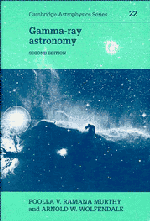2 - Gamma-ray line astronomy
Published online by Cambridge University Press: 06 July 2010
Summary
Introduction
The spectroscopy of γ-ray astronomy is, understandably, an area where important advances are to be expected, an expectation born of similar previous experience with other regions of the electromagnetic spectrum. Technical difficulties are considerable at present, however, due to low line fluxes aggravated by serious background problems; nevertheless, a promising start has been made and several interesting observations have already appeared.
As with astronomy in general, a distinction can be made between observations of ‘discrete’ objects (such as stars, supernovae, other galaxies, etc.) and signals from more extended regions, in particular the interstellar medium (ISM).
In the first category, γ-ray lines from the Sun – due to energetic protons and heavier nuclei interacting with the solar atmosphere – provide interesting and important information about a variety of solar phenomena. This subject of solar γ-ray spectroscopy is distant from the main stream of topics discussed here, and the reader is directed to a number of useful reviews by Ramaty and Lingenfelter (1981), Trombka and Fichtel (1982), Ramaty and Murphy (1987), and the books by Chupp (1976) and Hillier (1984).
In the non-solar region, which is of main concern here, only a few γ-ray lines have been detected from non-transient celestial sources so far. These include the lines at 1809 keV from the Galactic Equatorial Plane, the line at 511 keV from the Galactic Centre region and the one at 1369 keV from the object SS 433; these will be described in Sections 2.2, 2.3 and 2.4, respectively.
- Type
- Chapter
- Information
- Gamma-ray Astronomy , pp. 23 - 42Publisher: Cambridge University PressPrint publication year: 1993



